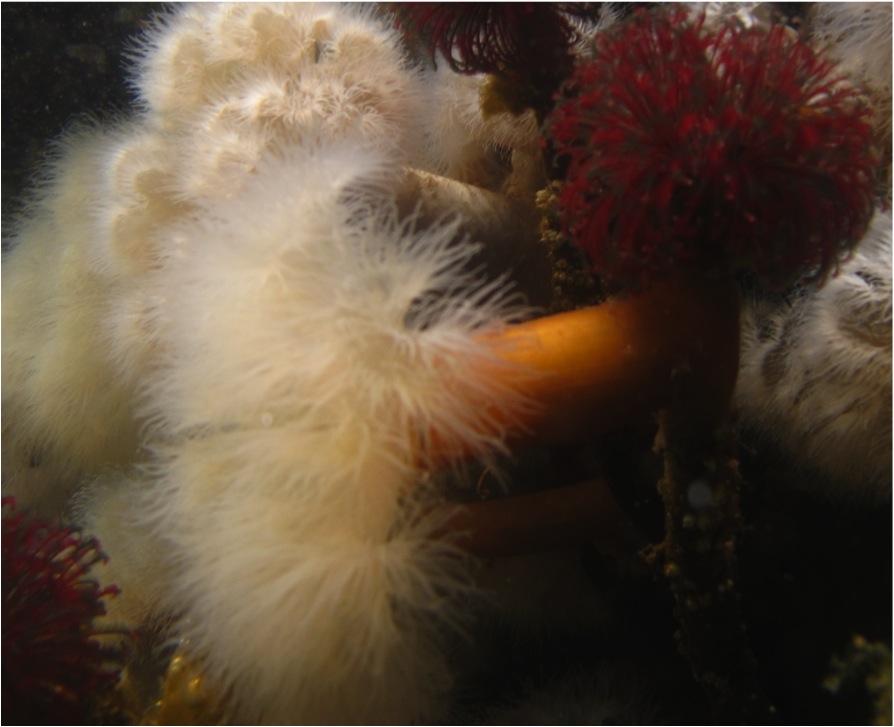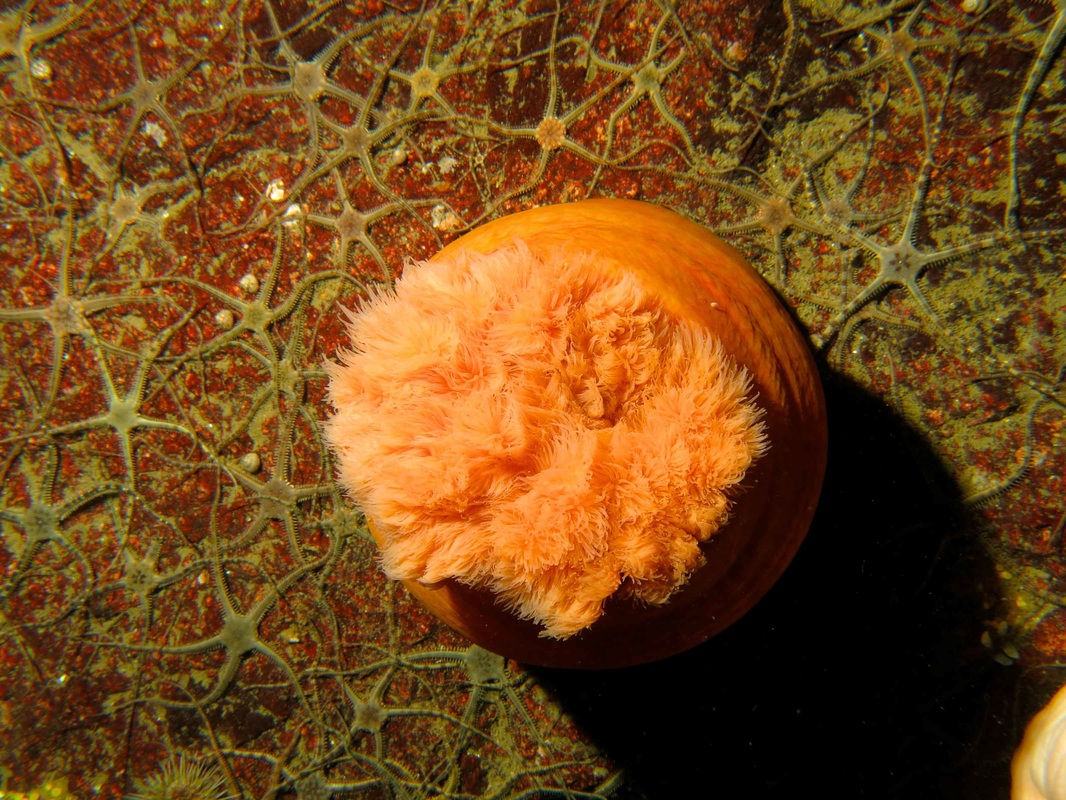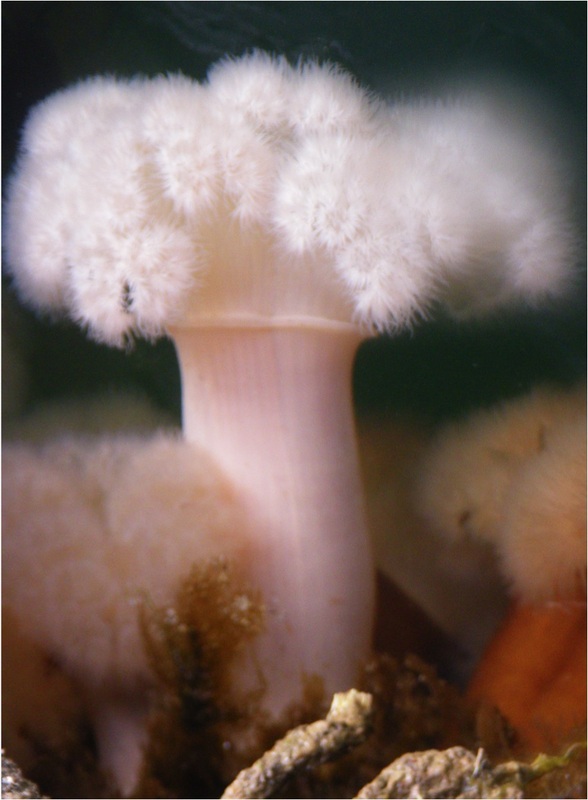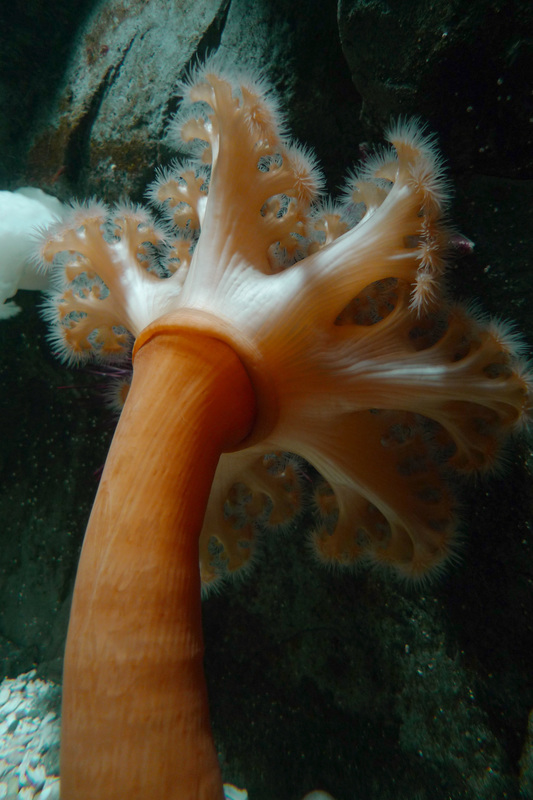Giant plumose anemone • Metridium farcimen, Metridium giganteum
Identification
This large anemone can reach 1 m in height, and has more than 200 thin, relatively short tentacles. It is usually white, but can also be brown, tan, or pinky-orange. Its oral disc is lobed and wider than its column, giving it a distinctly ruffled, cauliflower-like shape. Its column is smooth, with no tubercles. It can change proportions drastically — when the anemone contracts, the lobed oral disc disappears and the column shrinks down to a third of its full size or less. This species is colonial, and is usually found in large, dense groups of clones.
Habitat & Range
You can often find this species attached to the sides of docks, floats, and pilings. It will also attach to rocks and other hard surfaces, and is found in subtidal and intertidal areas to a depth of 300 m. It is a circumpolar species, found in northern Atlantic and northern Pacific coasts. Its range on the west coast of North America stretches from Alaska to southern California.
Similar Species
The short plumose anemone (Metridium senile) was only recently differentiated from the giant plumose anemone as a separate species. It gets no larger than 10 cm tall, has less tentacles (less than 100 instead of 200), and its oral disc is unlobed or only shallowly lobed.
Intriguing Info
This species is reportedly the world's tallest polyp. Dense colonies defend their territory against each other and other anemone species with acontia. The acontia do not noticeably sting human skin, but do not let them near your eyes or mouth as these areas are more sensitive. This species is preyed upon by the shaggy mouse nudibranch and the leather star.
This large anemone can reach 1 m in height, and has more than 200 thin, relatively short tentacles. It is usually white, but can also be brown, tan, or pinky-orange. Its oral disc is lobed and wider than its column, giving it a distinctly ruffled, cauliflower-like shape. Its column is smooth, with no tubercles. It can change proportions drastically — when the anemone contracts, the lobed oral disc disappears and the column shrinks down to a third of its full size or less. This species is colonial, and is usually found in large, dense groups of clones.
Habitat & Range
You can often find this species attached to the sides of docks, floats, and pilings. It will also attach to rocks and other hard surfaces, and is found in subtidal and intertidal areas to a depth of 300 m. It is a circumpolar species, found in northern Atlantic and northern Pacific coasts. Its range on the west coast of North America stretches from Alaska to southern California.
Similar Species
The short plumose anemone (Metridium senile) was only recently differentiated from the giant plumose anemone as a separate species. It gets no larger than 10 cm tall, has less tentacles (less than 100 instead of 200), and its oral disc is unlobed or only shallowly lobed.
Intriguing Info
This species is reportedly the world's tallest polyp. Dense colonies defend their territory against each other and other anemone species with acontia. The acontia do not noticeably sting human skin, but do not let them near your eyes or mouth as these areas are more sensitive. This species is preyed upon by the shaggy mouse nudibranch and the leather star.
References
Cowles, D. (2005). Metridium giganteum Fautin, Bucklin, and Hand, 1989. Invertebrates of the Salish Sea. Rosario Beach Marine Laboratory. Accessed 02/08/2013.
Harbo, R. M. (1999). Whelks to whales: Coastal marine life of the Pacific Northwest. Madeira Park, BC: Harbour Publishing. P. 43.
Lamb, A., and Hanby, B. (2005). Marine Life of the Pacific Northwest. Madeira Park, BC: Harbour Publishing. P. 85.
Authors and editors of page
Kelly Fretwell and Brian Starzomski (2013).
Cowles, D. (2005). Metridium giganteum Fautin, Bucklin, and Hand, 1989. Invertebrates of the Salish Sea. Rosario Beach Marine Laboratory. Accessed 02/08/2013.
Harbo, R. M. (1999). Whelks to whales: Coastal marine life of the Pacific Northwest. Madeira Park, BC: Harbour Publishing. P. 43.
Lamb, A., and Hanby, B. (2005). Marine Life of the Pacific Northwest. Madeira Park, BC: Harbour Publishing. P. 85.
Authors and editors of page
Kelly Fretwell and Brian Starzomski (2013).







